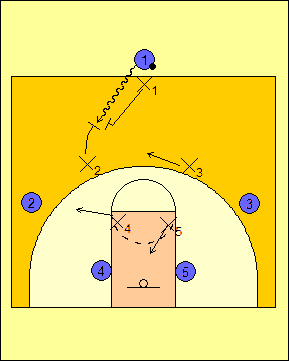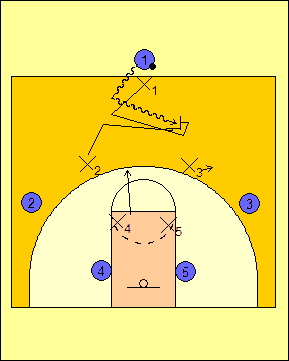|

Basketball Coaching DVD's at Championship Productions
SCRAMBLE DEFENSE
One of the greatest innovations of the coaching career of the legendary Dean
Smith was his famed Scramble Defense. This defense resulted from a trap
within the framework of a man-to-man defense that then turned into a trapping
defense with zone principles. Many teams have attempted to replicate what
Coach Smith pioneered at North Carolina and many have had great success with the
Scramble Defense.
The defense was a result of what Dean Smith learned from Phog Allen at Kansas
the year after Allen won his only NCAA Championship. The 1952-53 Kansas
Jayhawks were picked to finish near the bottom of the Big 7, but they made it
all the way to the national championship game for the second straight season
thanks to a defense that trapped certain ball-handlers. This
aggressiveness combined with the element of surprise gave Kansas a competitive
advantage, one that Coach Smith would take with him to the Air Force Academy as
an assistant to Bob Speer and later at North Carolina as the head coach.
Advantages of the Scramble Defense
Later in the article, I will discuss the goals of any pressure defense.
When a pressure defense like the scramble defense is implemented, the goals will
become more easily attainable. Like I said, I will save this for later.
However, there are two other big advantages that should also be taken into
consideration. The first of these is that the Scramble Defense is a great
change-up from man-to-man defense. Think of it this way: a dominant
baseball pitcher can throw a fastball in the mid- to upper-90's but still has
the devastating change-up that he throws in the low 80's that makes the hitters
swing off of their front foot. The Scramble Defense is a great change-up
to your man-to-man defense and gives the other team's offense something to think
about.
The other advantage is that the Scramble Defense is a great way to build team
chemistry. Because the defense allows any of the five players on defense
can come up with steals, this defense is a great way to get everyone to play
harder on the defensive end of the floor. When this happens, players get
excited, big plays happen, and the transition offense allows for easier scores
on the other end.
Disadvantages of the Scramble Defense
Because the Scramble Defense is a gambling-type defense, there is the
possibility of easy scores by the offense if the defense breaks down. When
this happens, the defense loses its potency and the other team's offense is able
to score. Sometimes, because of the nature of the Scramble Defense, this
can be a two-on-one situation, but rarely does this happen.
Another disadvantage of the Scramble Defense is that if all five of the players
do not play the defense the way it needs to be played, it can become disastrous.
You must have disciplined basketball players who understand their talents and
their limitations. If they do not, they can ruin the defense for everybody
else.
Goals of Any Pressure Defense
If your team runs a pressure defense, there are three
goals that should be established for any given possession. During
the course of the game, it will be to your advantage to determine the
success rate of your defense based on whether or not the defense was
successful in accomplishing these aims:
1) Steal the basketball. If you steal the
basketball you can start your transition offense and score easily.
Generate enough steals and you can win the game with your transition
offense and your pressure defense.
2) Force a deadball turnover. This is
somewhat similar to #1 in that the other team's offense turns the
basketball over thanks to the pressure. However, this goes into a
separate category considering that you cannot fast break off of a
deadball turnover. Instead, this is a time to take advantage of
the other team losing an offensive scoring opportunity and you getting
one as a result.
3) Rebound the first missed shot. Teams
that are able to get second-chance shots are more likely to win games.
If you are playing a pressure-type defense, you will be forcing
contested shots. Contested shots are more likely to be missed
which means that you will need to get the rebound. Also, if your
team allows second-chance shots, you are giving the other team more
scoring opportunities.
The bottom line is that every pressure defense should be
designed in such a way to create more scoring chances for your team and
fewer for your opponents. Keep this in mind as we go through the
intricacies of the Scramble Defense.
Types of Scramble Defense
In the Scramble Defense, there are two types of Scramble Defenses. The
first is the dribble trap and the second is the pass trap. They are
distinguished based on the action that takes place once the ball crosses a
particular pick-up point. For example, a half court dribble trap is what
takes place when the point guard dribbles the ball across the half court line as
he does in Diagram 1. When this happens, the trap is sprung with the two
nearest defenders to the trap acting as interceptors and the furthest defender
from the ball becoming the goaltender.

Diagram
1 |
If the point guard attempts a reverse dribble, the
Scramble Defense can still be sprung after the point guard sees the
trap coming and reverses his field. Diagram 2 shows the point
guard being turned by X1 and seeing X2 coming for the trap. X1
and X2 stay with the play and ultimately force the trap.

Diagram
2 |
The traps in the Scramble Defense off of the dribble can
come from either in front or from behind. Diagram 3 shows how the
defense rotates when the trap is from in front of the dribbler while
Diagram 4 shows what happens when the trap comes from behind. When
selecting a way to trap off of the dribble, it is best to pick one way
and stay with it through the season.

© 2010-2017 Alan Peel Enterprises
|